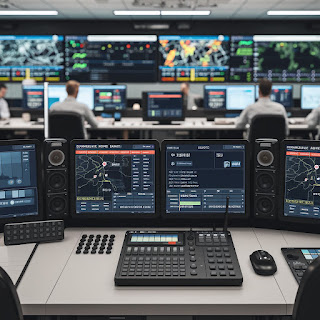Yesterday’s Emergency: A Distress Call Sparks Rapid Multi-State Response
Yesterday at about 3:15 PM Eastern, there was a potentially serious emergency at the private home of an American State National. The use of their calibrated emergency communication radio device to make a distress call while being approached by a process server was shown to be highly useful on multiple levels.
To protect privacy and increase the effectiveness of future scenario-based preparedness, the precise time, location, and name of the lawful individual/s in distress at the time of the incident have been intentionally veiled in approximation.
Rapid Multi-State Activation
The distress call was instantly received by the APCMD Communication Center in Nevada and the Peacekeeping Task Force Central Office, both of which verified that the situation was live and not a drill. At least four separate states were monitoring the distress call actively as witnesses, confirming and supporting the importance of the event as it unfolded. Key emergency network developers within the same state were also online, operating as part of their own State Emergency Network and First Responder teams. Although still in their infancy, the team was ensuring that every aspect of the incident was observed and supported by recognized lawful personnel-in-training.
Real-Time Communication and Support
During the course of about 30 minutes, several radio communications took place.
Peacekeepers and network members gave real-time instruction, advice, reassurance, and safety directions to the homeowner - to include, but not limited to the important action of securing large, upset canines for the safety of everyone involved.
Immediately after the encounter was announced all audio communication was recorded by the participating State Dispatch center, providing a complete record of evidence and transparency for all parties concerned - no matter the ultimate purpose of the encounter.
This live, real-world exercise demonstrated the integral need for regular, scenario-based training exercises involving State Assembly Militia members in this type of situation.
The ability to instantaneously identify the specifics of an incident and provide accurate reporting of location was directly a product of sustained intent training in managing high-stress contact with de facto law enforcement and other worst-case scenarios - real or imagined.
Practice communications are essential to achieving the clarity, speed, and accuracy required in emergency events.
Without this preparation, there can be significant gaps in message transmission that can compromise both safety and response time.
Technology and Network Infrastructure
The emergency communication equipment, also approved and owned by the Federation Fiduciary Office, is designed for safe long-distance information flow, approved emergency geo-location tracking, and real-time evidence collection.
The equipment allows the rapid relay of critical information and is founded upon best practices in public safety and emergency response availableat this time, enabling all American State Assemblies and Union State Assemblies on the County level to have immediate access to sight and sound information emergency communication infrastructure technology.
This approach mirrors national standards for interoperability and reliability in emergency communications alongside all modern systems and digital applicatios, ensuring that even in high-stress or disaster scenarios, information flows seamlessly between agencies, offices and responders.
Transparency and Public Accountability
A full account of the incident, including the role the emergency communication network played, will appear in a special feature of the Peacekeeping Task Force blog in tbe future during every reported encounter.
This disclosure is made to inform the public of the availability and effectiveness of these emergency services and to advise agencies with potential bad-actors among them involved in questionable process serving practices that all such meetings are being observed and recorded for lawful analysis.
The Peacekeeping Task Force is committed to providing ongoing updates and detailed local peace-matters interaction information, further enhancing transparency and public trust.
Participation in The American Peacekeeping Communications Mobile Dispatch (APCMD) and PeaceBridgeNetwork (a fully Digital Network Networking Center) crucial to enhance emergency communications and logistical movement needs in any high-stress situation.
These networks enable quick dissemination of information, clarity in messaging, and coordinated response capacity, which can only be developed through continued participation and scenario-based training.
As emergencies and threats continually evolve, robust and well-coordinated communication systems become the foundation of community safety and resilience.
This recent event is a powerful reminder that readiness, technology, and cooperation can, and will do its part towards protecting American families and strengthen the principles of lawful and legal boundaries that will always exist between emergency responses.
The combined efforts of State Assembly Militia members, emergency network developers, and multi-state witnesses ensured that the situation was managed with professionalism, transparency, and a commitment to public safety.














